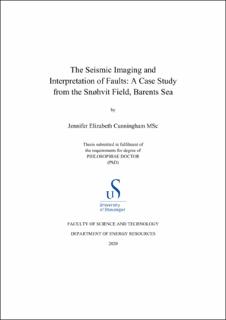| dc.contributor.advisor | Cardozo, Nestor | |
| dc.contributor.advisor | Townsend, Chris | |
| dc.contributor.author | Cunningham, Jennifer Elizabeth | |
| dc.date.accessioned | 2021-01-07T14:48:20Z | |
| dc.date.available | 2021-01-07T14:48:20Z | |
| dc.date.issued | 2021-01 | |
| dc.identifier.citation | The Seismic Imaging and Interpretation of Faults: A Case Study from the Snøhvit Field, Barents Sea by Jennifer Elizabeth Cunningham. Stavanger : University of Stavanger, 2021 (PhD thesis UiS, no. 568) | en_US |
| dc.identifier.isbn | 978-82-7644-981-5 | |
| dc.identifier.issn | 1890-1387 | |
| dc.identifier.uri | https://hdl.handle.net/11250/2722081 | |
| dc.description.abstract | An accurate understanding of faults in the subsurface is critical to successful petroleum exploration and production. Faults define sediment distribution pathways during deposition, act as barriers or conduits to fluid flow, and can define or compromise hydrocarbon traps. Faults are commonly analysed in the petroleum industry using reflection seismic data, and more rarely core or borehole image data. Outcrop analogues are used to provide a more complete understanding of fault rock morphologies and properties. In seismic data however, faults are often imaged as discontinuities where geological horizons are vertically and horizontally displaced. Due to the limited resolution of seismic data (typically tens of metres) comparatively little can be concluded about fault morphology, internal structure or the detailed interaction of faults with seismic waves.
The first paper in this thesis focuses on bridging the knowledge gap in the seismic imaging of faults by analysing how the seismic processing methods of incidence angle stacking and azimuthal separation influence fault imaging. This first paper also studies the relationship between fault orientation and seismic acquisition direction, and the impact on the seismic imaging of faults in the subsurface. The paper also demonstrates that the internal complexity of faults can influence the dominant seismic frequencies observed in and adjacent to complex fault zones.
The second paper in this dissertation integrates established and newly developed analyses in fault interpretation and seismic imaging. Analyses of throw, dip distortion, seismic attributes, unsupervised fault facies and seismic amplitudes in seismic fault analysis were applied. These attributes were compared to establish the geological significance of the seismic signature in and around faults. The paper proposed a linkage between unsupervised seismic fault facies, throw and dip separation gradient which are inherently linked to the mechanical stratigraphy which controls fault propagation and growth. Systematic variations in observed seismic amplitudes were found to be related to fault propagation folding and the formation of synclines and anticlines. The analyses applied in this paper can provide a more concrete methodology for analysing and understanding fault systems and when compared to conventional seismic interpretation methods, it can yield far more information on fault morphologies and interactions.
Faults in seismic data are commonly interpreted on a combination of reflection seismic data and attributes derived from the same reflection data. Fault sticks are typically interpreted on vertical sections through the data volumes and then these sticks are gridded into fault surfaces. This methodology has been in place for decades, but an investigation into the impact of fault and horizon interpretation methodologies on the geological accuracy of the resulting fault surfaces has not been published. The third paper in this dissertation tests five interpretation experiments with the aim of uncovering the impact of interpretation strategy on fault and horizon morphology, fault length, and vertical displacement. The most and least successful interpretation methods were further examined to demonstrate the impact of interpretation method on geological modelling workflows and the calculation of hydrocarbon volumes. This paper proves the importance of a denser fault interpretation methodology on the resulting structural analysis, geomodelling and the estimation of petroleum reserves. It also suggests a best practice on how to approach the interpretation and modelling workflow.
Having the best possible understanding of the imaging, seismic signature and interpretation of faults in seismic data is crucial for geoscientists working in hydrocarbon exploration and production. This thesis aims to strengthen the geoscientific understanding of faults and provides clear observations, conclusions and recommendations that can improve the use of existing seismic datasets and optimise the acquisition and processing of future seismic surveys. | en_US |
| dc.language.iso | eng | en_US |
| dc.publisher | Stavanger, University of Stavanger | en_US |
| dc.relation.ispartofseries | PhD thesis UiS;568 | |
| dc.relation.haspart | Paper 1: Cunningham, J., Weibull, W., Cardozo, N. et al. Investigating the Seismic Imaging of Faults Using PS Data from the Snøhvit Field, Barents Sea and Forward Seismic Modelling (In review at Petroleum Geoscience) | en_US |
| dc.relation.haspart | Paper 2: Cunningham, J., Cardozo, N., Townsend, C. et al. (2019) Fault Deformation, Seismic Amplitude and Unsupervised Fault Facies Analysis: Snøhvit Field, Barents Sea. Journal of Structural Geology, 118, pp. 165-180. | en_US |
| dc.relation.haspart | Paper 3: Cunningham, J., Cardozo, N., Townsend, C. et al. The Impact of Seismic Interpretation Methods on the Analysis of Faults: A Case Study from the Snøhvit Field, Barents Sea. In review at Solid Earth. | en_US |
| dc.subject | petroleumsgeologi | en_US |
| dc.subject | faults | en_US |
| dc.title | The Seismic Imaging and Interpretation of Faults: A Case Study from the Snøhvit Field, Barents Sea | en_US |
| dc.type | Doctoral thesis | en_US |
| dc.rights.holder | ©2020 Jennifer Elizabeth Cunningham | en_US |
| dc.subject.nsi | VDP::Teknologi: 500::Berg‑ og petroleumsfag: 510::Geoteknikk: 513 | en_US |
| dc.subject.nsi | VDP::Matematikk og Naturvitenskap: 400::Geofag: 450::Petroleumsgeologi og -geofysikk: 464 | en_US |
